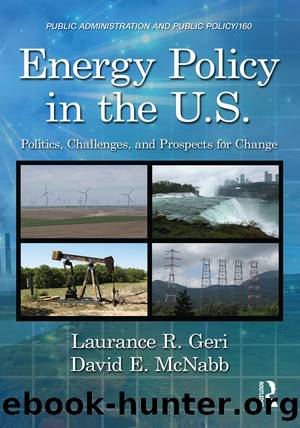Energy Policy in the U.S.: Politics, Challenges, and Prospects for Change by Laurance R. Geri & David E. McNabb

Author:Laurance R. Geri & David E. McNabb [Geri, Laurance R. & McNabb, David E.]
Language: eng
Format: epub
Tags: Political Science, General
ISBN: 9781351568296
Google: 0h03DwAAQBAJ
Goodreads: 36761103
Publisher: Routledge
Published: 2011-06-03T00:00:00+00:00
A Major Presidential Theme
President Obama has made support for energy research a major theme of his administration. In an address to the National Academy of Sciences in 2009, he established the goal of devoting 3 percent of gross domestic product (GDP) overall to R&D, and confirmed that âenergy is our great project, our generationâs great project. And thatâs why Iâve set a goal for our nation that we will reduce our carbon pollution by more than 80 percent by 2050.â The Obama 2010 budget proposal included $150 billion in funding over 10 years to support renewable energy, energy efficiency, climate research, and the creation of the Advanced Research Projects Agency for Energy, or ARPA-E.
The Department of Energyâs research and development programs are substantial, including 17 national laboratories and many specific programs focusing on basic science and particular technologies. The overall budget for the departmentâs science, discovery, and innovation programs for fiscal year 2009 was $3.7 billion; this omits $2.2 billion from the Energy Efficiency and Renewable Energy division of the DOE, plus $5.5 billion in Recovery Act funds for R&D.
Basic science programs include Basic Energy Sciences, Advanced Scientific Computing, Biological and Environmental, High Energy Physics, Nuclear Physics, and Fusion Energy Sciences. Energy efficiency and electricity programs include Energy Efficiency and Renewable Energy, Electricity Delivery and Energy Reliability, The Energy Transformation Acceleration Fund, and Nuclear Energy. In addition, several other initiatives are underway. The DOE is establishing several Energy Innovation Hubs ($135 million proposed over 5 years) that will bring together researchers with science, engineering, and policy expertise to focus on critical national needs.
Energy Frontier Research Centers are being created to research the fundamental science needed to move past barriers to advance revolutionary energy technologies, such as energy storage. Finally, ARPA-E will support research that has the potential for high commercial impact but is too risky to be funded by private investors. ARPA-E initially received $400 million in ARRA funding and a further $300 million is requested for the program in FY 2011. This is an impressive amount of activity.
There are several underlying assumptions behind the large increase in government energy R&D funding. One is that a policy creating a clear carbon price will not be sufficient to transform the U.S. energy sector. It would help to change the profile of electricity generating sources in the country. But additional breakthroughs in wind power, concentrated solar power photovoltaics, vehicle batteries, and energy storage will be needed to accelerate the pace of change.
A second is that the historical pattern of government spending on energy R&D has been inadequate and erratic. Overall, R&D in the energy sector has been problematic since the inception of the Department of Energy. In the United States as a whole, the private sector provided about two-thirds of the countryâs total of $389 billion in R&D expenditures in 2009 (about $253 billion), with the U.S. government picking up 28 percent ($109 billion). But the energy sector has been a laggard, with 2009 investments of only about $3 billion, in an industry with about $1.
Download
This site does not store any files on its server. We only index and link to content provided by other sites. Please contact the content providers to delete copyright contents if any and email us, we'll remove relevant links or contents immediately.
The Future of Packaging by Tom Szaky(487)
Hacking Planet Earth by Thomas M. Kostigen(435)
Rebuilding Earth by Teresa Coady(435)
How to Open & Operate a Financially Successful Landscaping, Nursery, or Lawn Service Business by Lynn Wasnak(383)
Hacking Planet Earth: How Geoengineering Can Help Us Reimagine the Future by Thomas M. Kostigen(380)
The Circular Economy by Stahel Walter R.;(377)
Making Jeans Green by Paulina Szmydke-Cacciapalle(365)
A River Runs Again by Meera Subramanian(353)
Social Entrepreneurship and Innovation by Ken Banks(340)
Managing Business Ethics: Making Ethical Decisions by Alfred A. Marcus & Timothy J. Hargrave(313)
Work Like Nature by Lea Elliott(294)
The Clean Energy Age by BF Nagy(271)
Strategic Corporate Conservation Planning by Margaret O'Gorman(263)
Valuing Nature by William Ginn(261)
When Smoke Ran Like Water: Tales Of Environmental Deception And The Battle Against Pollution by Devra Davis(250)
How to Open and Operate a Financially Successful Landscaping, Nursery, or Lawn Service Business by Lynn Wasnak(248)
Exploring Environmental Ethics by Kimberly K. Smith(219)
Turning the Tide on Plastic: How Humanity (And You) Can Make Our Globe Clean Again by Lucy Siegle(197)
The impossibilities of the circular economy : separating aspirations from reality by Harry Lehmann Christoph Hinske Victoire de Margerie and Aneta Slaveikova Nikolova(56)
